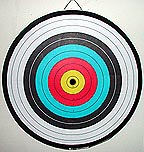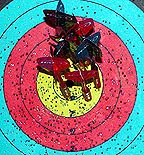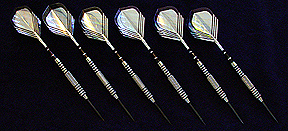

Unconventional Dart Game Discussion with pictures of a different game to play with darts
(Click on main site to browse 70 other topics ranging from exotic kaleidoscope designs to the strange world of lucid dreaming.)
I
can't recall ever throwing darts in my life, so it came as a
pleasant surprise when my wife gave me a dart board for Christmas of
2002. My only experience with projectile sports was archery back in
college. Consequently I expected to be throwing at something similar
to a ten-ring, gold, red, blue, black, and white target. I was
dumbfounded at the complexity of the dart target. What made matters
worse was that upon attempting to hit the bull's eye, I not only
missed but often missed the entire board! Even more astounding was
that the value areas were separated by thick wires that regularly
blocked a dart from sticking. Then I read the rules and was
completely confused. Some of the highest scoring zones are far from
the center. Weirder still was the fact that areas of equal size and
shape had grossly different values. To an old archer like myself,
this was too much. I had to come up with something else. I did.

A local archery store carried standard 40-centimeter (16-inch) diameter targets. These fit perfectly on the back side of the dart board, the side with the baseball game that has no wires on it. With the archery target stapled to the board I at last had something familiar to throw at. I grabbed the six darts that came with the board (In archery you shoot in "ins" of six arrows. I adopted the same convention for my unconventional dart game.) and at a distance ten feet, started hurling away. I loved it. Sure, the wall around the target still got peppered with holes, but over time the groupings started to tighten.
On to phase two of unconventional darts: The game.
Throwing darts is a lot more fun if you have a standard to measure progress. For this I once again drew upon my archery roots. Back in 1972 at Glendale (California) Community College, the standard practice round was the Chicago Round: 96 arrows at a 16-inch target at 20 yards. For my game, I made it 96 darts in "ins" of six darts at ten feet using the same 16-inch target. The center of the target is hung five feet above the floor. This turned out to be fortuitous because after a month of throwing, my dart game scores were averaging the same as my archery scores: 725 out of a possible 960.
This game is simple: get as many darts in the gold as possible. There are no worries about strategy or scoring formulas. For an untalented beginner like myself, it is also extremely challenging. At ten feet, even the slightest imperfection in a throw can send a dart far out in to the blue, black or even (gasp) the white zone. Yet, in rare moments when I get into "the groove" I can break into the 50+ score for an "in" of six darts. So far, I've only gotten a perfect "in" once for a score of 55, as recorded below. (In archery any solid gold "in" is usually considered perfect. In ten-ring scoring, I suppose to be perfect all six darts would have to be within the "ten" ring for a score of 60.)
With practice I hope "solid golds" become a regular occurrence. Wish me luck!

Of course, there are many variations possible. Any number of "ins" can be used to make a standard game that fits your time and preferences. Reducing the number of "ins" may be advisable if you're throwing against someone else because 192 darts takes an hour for two people to throw. Even simpler games are possible. For example, you could say the winner is the person with the highest single-in score out of four or five "ins."
I encourage you to keep the 6-dart "in" as standard, even if it goes against the tradition of sets of three darts. The reason is that with only three darts you're always starting and stopping with little chance to get into a groove. Throwing more than six darts becomes a problem because once you get proficient, the center of the target gets too crowded.
One thing I like about the 96-dart Chicago round is that the score is an absolute or quantitative measure of skill. With this system, people could compete over the Internet simply by posting their scores on a central site... assuming they did so honestly.
If you're a dart thrower and are looking for something new, find an archery store, get a 16-inch target, and try this game. If you're good it may be too easy. If so, move back until you miss regulary, then work on getting better. I'd enjoy hearing from anyone who tries it.
NEW!!! How I'm getting better!
In the three weeks since opening this page, I've improved my throwing at what can only be considered a glacial rate. When I first started, I was lucky to throw a 650 Chicago round. Now I'm averaging 790 and have a personal best of 804.
I've found a few techniques that helped a lot and would like to pass them along to anyone interested in improving their throwing. Please, remember, I'm a beginner at darts. I strongly recommend that anyone wishing to throw better go to an experienced thrower and seek their more learned advice.
1. The first thing I learned is that the less I moved my body the more consistently I threw.
2. Next, I found that I tended to lower my head as I concentrated on the target. This resulted in my looking through the top half of my glasses which resulted in a blurred image of the target. Keeping my head up sharpened my view of the target and my accuracy.
3. I've heard that visualization is important in any sport. I've never found this more true than with darts. While preparing for a throw, I find I do much better if I visualize the throw and imagine the dart going into the bullseye. This isn't a static image, but a moving image of my throwing the dart. More than that, I find it helps to recall what a good throw feels like and what a dart landing in the gold sounds like.
4. The only source I located on dart throwing suggests keeping an eye fixed on the target. I found that I throw more golds when I broaden my field of view to follow my arm movement enough to make sure it's tracking toward the gold.
By applying these techniques, I've picked up eight more solid gold "ins." I'm still no good... but I'm, happy to say that I'm getting better
Now I'd like to share a thought about why darts are so hard and why I think increasing the throwing distance an additional two-feet, 2 and 3/4-inches from the official 7', 9 and 1/4-inches more than doubles the difficulty.
Consider billiards and archery. In these sports you use both arms to create a triangle support system to provide a solid base to guide your movements. In darts, you throw with one arm extended without anything else to support it or help guide the throw to its target. Without additional support, an extended arm is like a multi-hinged cantilever, free to move in many directions... mostly away from the gold you want to hit. The act of throwing creates inertia which, when working along the arm's complex structure, makes keeping it on a straight track almost impossible.
The reason I claim a 2-foot increase in throwing distance more than doubles the difficultly is that at this range the darts are falling almost as fast as they are moving forward. Small changes in throwing speed result in larger changes in drop compared to the closer distant. Throwing harder reduces this effect but makes throwing accuracy more difficult.
I rewarded myself for throwing an 804 by purchasing a set of good darts to replace the Halax cheapos ($1.89 for three darts) I had been using. Vickie Williams, the manager of Darts and Things (http://www.dartsandthings.com), very graciously spent an hour with me letting me try different darts and helping me with my technique. In the end, the darts that felt the best were 24-gram Great Whites.

I can't say that they've improved my scores, but they are a lot more fun to throw.
Return to My Main Page and Browse 32 Other
Interesting Subject Pages